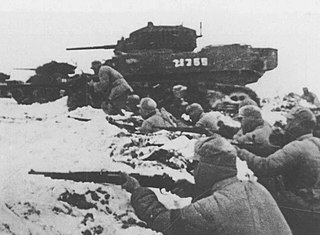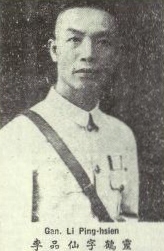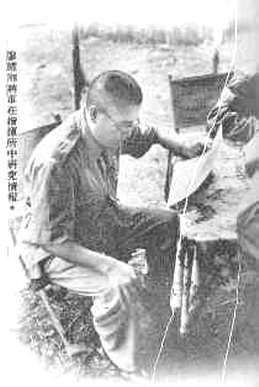History
In 1937 the North China Area Army had chased Song Zheyuan's 29th Army to the south along the Jinpu Railway (see Tianjin–Pukou Railway Operation) after his defeat in the Battle of Lugou Bridge. After Japan won the Battle of Nanjing, the North China Area Army advanced southward to establish a Japanese connection between Beijing and Nanjing, ignoring the non-expansionist policy of the Imperial General Headquarters in Tokyo. Most mechanized and air forces in eastern China were wiped out in the Battle of Shanghai, which concluded in late November 1937. Although new equipment was purchased, it had yet to be shipped. Han Fuqu, the chairman of the Shandong province, rejected orders from Chiang Kai-shek and kept retreating to preserve his force. After Qingdao was occupied in January 1938, Han's policy was denounced and he was executed on 24 January. In March 1938 Japanese forces occupied the north of Shandong, including the capital city Jinan. The defense line along the Yellow River was torn apart. Due to pressure from Japanese forces, 64 Chinese divisions gathered around Xuzhou in Jiangsu, the headquarters of 5th Military Region of the National Revolutionary Army. Without surrounding it, Gen. Itagaki Seishiro moved south first to attack Tai'erzhuang, where he was defeated by Li Zongren in a regional asymmetric battle.
Following this defeat, Japan intended an encirclement against Xuzhou and deployed the North China Area Army to the north and the Central China Expeditionary Army to the south. The North China Area Army had four divisions and two infantry brigades drawn from the Kwantung Army. Central China Expeditionary Army had three divisions and the 1st and 2nd Tank Battalions with motorized support units formed into the Iwanaka and Imada Detachments, which were ordered to advance to the west of Xuzhou to cut off and prevent Chinese forces from withdrawing towards the west. The 5th Tank Battalion was used to support the 3rd Infantry Division advancing north along the railway to Xuzhou. Additional troops were deployed in the Battle of Northern and Eastern Henan by the North China Area Army to stop Chinese reinforcements from the west. A Chinese counterattack here resulted in the Battle of Lanfeng. However, with the approach of the Central China Expeditionary Army from the south, the overall situation was grim, and Chiang Kai-shek ordered the withdrawal of the armies. The demolition of the dykes holding back the Yellow River allowed him more time for the preparation of the defense of Wuhan, but the resulting 1938 Yellow River flood also destroyed much of the area around the new course of the river and claimed appalling losses among chinese civilians: est. 400,000–500,000 dead and 3 million refugees. [1]
The Japanese army won the fierce battle and ultimately captured Xuzhou, but Japanese forces were too small to contain the large number of encircled Chinese troops. Most of the Chinese soldiers broke through the encirclement through gaps in the Japanese lines to the west or dispersed into the countryside as guerrillas. By successfully breaking out of the Japanese encirclement, the Chinese were able to preserve most of their forces. These units would form approximately 50% of the Chinese forces participating in the Defense of Wuhan.

The Northern Expedition was a military campaign launched by the National Revolutionary Army (NRA) of the Kuomintang (KMT), also known as the "Chinese Nationalist Party", against the Beiyang government and other regional warlords in 1926. The purpose of the campaign was to reunify China, which had become fragmented in the aftermath of the Revolution of 1911. The expedition was led by Generalissimo Chiang Kai-shek, and was divided into two phases. The first phase ended in a 1927 political split between two factions of the KMT: the right-leaning Nanjing faction, led by Chiang, and the left-leaning faction in Wuhan, led by Wang Jingwei. The split was partially motivated by Chiang's Shanghai Massacre of Communists within the KMT, which marked the end of the First United Front. In an effort to mend this schism, Chiang Kai-shek stepped down as the commander of the NRA in August 1927, and went into exile in Japan.

Du Yuming, was a Kuomintang field commander. He was a graduate of the first class of Whampoa Academy, took part in Chiang's Northern Expedition, and was active in southern China and in the Burma theatre of the Sino-Japanese War. After the Japanese surrendered in 1945, he was an important commander in the Chinese Civil War.

Chen Cheng was a Chinese political and military leader, and one of the main commanders of the National Revolutionary Army during the Second Sino-Japanese War and the Chinese Civil War.

Gu Zhutong, courtesy name Moshan (墨山), was a military general and administrator of the Republic of China.

The Battle of Wuhan, popularly known to the Chinese as the Defence of Wuhan, and to the Japanese as the Capture of Wuhan, was a large-scale battle of the Second Sino-Japanese War. Engagements took place across vast areas of Anhui, Henan, Jiangxi, Zhejiang, and Hubei provinces over a period of four and a half months. It was the longest, the largest, and arguably the most significant battle in the early stages of the Second Sino-Japanese War. More than one million National Revolutionary Army troops from the Fifth and Ninth War Zone were put under the direct command of Chiang Kai-shek, defending Wuhan from the Central China Area Army of the Imperial Japanese Army led by Shunroku Hata. Chinese forces were also supported by the Soviet Volunteer Group, a group of volunteer pilots from Soviet Air Forces.

The 1938 Yellow River flood was a man-made flood from June 1938 to January 1947 created by the intentional destruction of dikes (levees) on the Yellow River. The first wave of floods hit Zhongmu County on 13 June 1938.

The Huaihai campaign, or Battle of Hsupeng, was one of the military conflicts in the late stage of the Chinese Civil War between the Kuomintang and the Chinese Communist Party. The campaign started when the People's Liberation Army (PLA) launched a major offensive against the Kuomintang headquarters in Xuzhou on 6 November 1948, and ended on 10 January 1949 when the PLA reached the north of the Yangtze.
Sun Yuanliang was a Chinese military general of the National Revolutionary Army of the Republic of China. Sun was the last surviving member of the first graduating class of the Whampoa Military Academy, as well as the last surviving army-level commander of the Second Sino-Japanese War. His career spanned the January 28 Incident, Second Sino-Japanese War and the Chinese Civil War.

The Central Plains War was a series of military campaigns in 1929 and 1930 that constituted a Chinese civil war between the Nationalist Kuomintang government in Nanjing led by Generalissimo Chiang Kai-shek and several regional military commanders and warlords who were former allies of Chiang.

Pang Bingxun was a high-ranking nationalist military commander who fought against the Imperial Japanese Army and Chinese Communist Army. He stopped the IJA 5th Division led by General Seishirō Itagaki, one of the principal architects of the 1931 Manchurian incident, from capturing Linyi and converging with General Rensuke Isogai's IJA 10th Division at Tai'erzhuang District, foiling their plan to assault Xuzhou.

The 13th Division was an infantry division in the Imperial Japanese Army. Its tsūshōgō code name was the Mirror Division, and its military symbol was 13D. The 13th Division was one of four new infantry divisions raised by the Imperial Japanese Army (IJA) in the closing stages of the Russo-Japanese War 1 April 1905, after it turned out what the entire IJA was committed to combat in Manchuria, leaving not a single division to guard the Japanese home islands from attack.

Li Pinxian was a Republic of China Army general from Cangwu County, Guangxi. His career spanned the Xinhai Revolution, Warlord Era, the Second-Sino Japanese War, and the Chinese Civil War. After the loss of the mainland to the Chinese Communist Party in 1949, he left for Taiwan.

Wang Yaowu was a high-ranking KMT general and the Governor of Shandong Province who successfully fought against both the Imperial Japanese Army and the Chinese Communists. In September 1948, Communist forces launched the Battle of Jinan. Wang was captured and held as a prisoner of war until his pardon and release in 1959. During the Cultural Revolution he came under attack by the Red Guards for being a former nationalist commander and died of a heart attack in 1968.
Huang Baitao, also known as Huang Botao (黄伯韬), was a Chinese Nationalist general active in the Second Sino-Japanese War and Chinese Civil War, for which he was twice awarded the Order of Blue Sky and White Sun, the second highest military award in the Nationalist and then Republic of China military honors system.

Qiu Qingquan was a ROC Army general who excelled himself in Northern Expedition, anti-communist Encirclement Campaigns, Second Sino-Japanese War, and Chinese Civil War. In the Huaihai Campaign, which was determining battle of the Chinese Civil War, he failed to save General Huang Baitao's 7th corps and later committed suicide on the battlefield.

Liao Yiaoxiang, was a high-ranking Kuomintang commander who successful fought against both the Imperial Japanese Army and Chinese Communist forces. Apart from General Sun Liren, he was one of the few Nationalist commanders who graduated from a military academy in the West. After the end of the Second Sino-Japanese War, he served as a field commander in Manchuria until his capture by Marshal Lin Biao's Manchurian Field Army in the Liaoshen Campaign. General Liao was held for 12 years as a prisoner of war until 1961 and died seven years later during the Cultural Revolution.

The National Pacification Army (NPA), also known as the Anguojun or Ankuochun, was a warlord coalition led by Fengtian clique General Zhang Zuolin, and was the military arm of the Beiyang government of the Republic of China during its existence.














